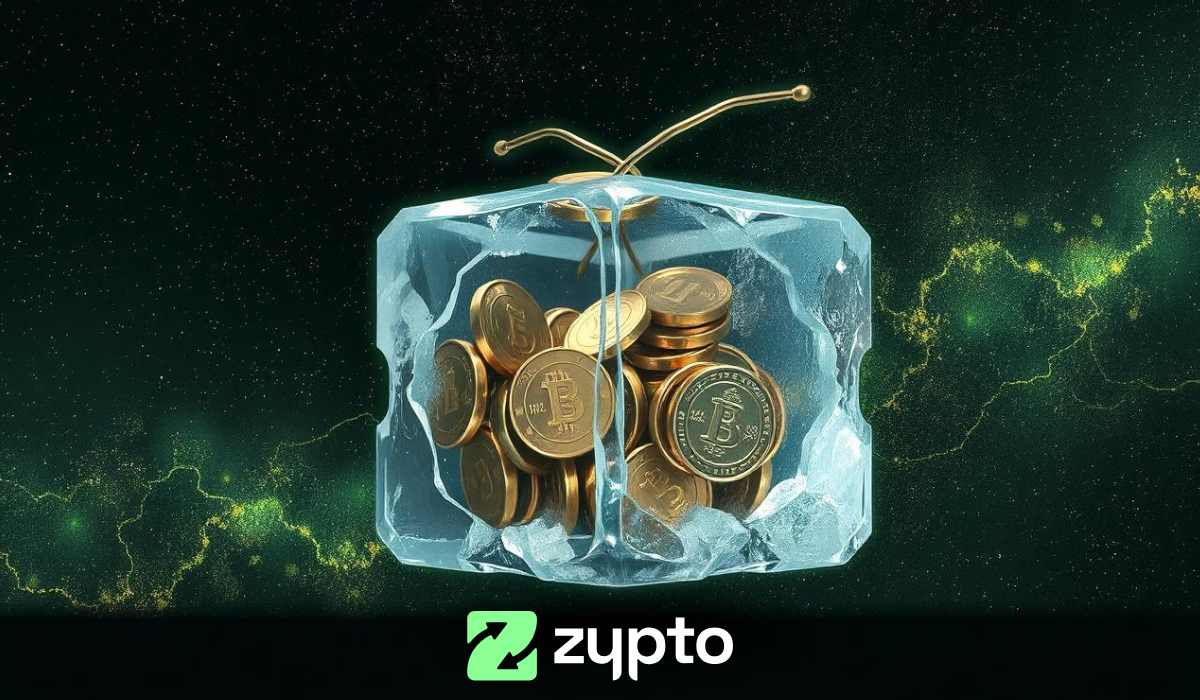Blockchain technology has become a buzzword in recent years, but what exactly is it? Blockchains are best known for their crucial role in maintaining a secure and decentralized record of transactions in cryptocurrency systems.
Even if you’re not familiar with blockchain or blockchain technology, you’ve likely heard it mentioned in everyday cryptocurrency discussions. According to McKinsey research, by 2027, up to 10% of global GDP may be linked to blockchain-enabled transactions. This indicates significant untapped potential for blockchain and the possibility of increased widespread adoption over time.
Despite its growing popularity, not many people truly understand the entire idea behind blockchain technology. Is it just hype? Will the buzz around it fade out, or can businesses truly leverage blockchain to create value? How exactly does it power crypto? Read on to find out.
What is blockchain technology?
A blockchain is a digital ledger that records and confirms cryptocurrency transactions across a network of computers. When you buy, sell, or exchange cryptocurrency, the blockchain collects and securely stores this information. Essentially, it’s a chain of continuously growing blocks, with each block containing a list of encrypted transactions.
To drive the point home, let’s use an easy analogy. Imagine having a book where you record transactions. Every time you make a transaction, the book is updated. Now, picture this book being made available to several others at the same time.
That’s the basic idea of blockchain technology – a digital ledger shared across a network. Every time someone makes a transaction, it’s recorded in this shared ledger.
Unlike traditional financial systems, the data processed by blockchain technology is kept in a decentralized network, free from government or other third-party oversight or control. Because everyone on the network can access the entries made by others, no one can manipulate or have sole control of the network.
Each block in a blockchain is encrypted for security and linked to the previous block, creating a chain of transactions – hence the term “blockchain.” This structure ensures that data stored on the blockchain cannot be deleted or modified without the consensus of the entire network, providing a transparent, robust, and tamper-resistant data exchange system.
Aside from its obvious use case of providing a medium for crypto-related transactions, this emerging technology has a host of other application potential. But before we look into those, let’s quickly highlight the key features of blockchain technology.

Key features of blockchain technology
Here are some of its distinguishing features:
Decentralization
This is one of the hallmarks of blockchain technology. Unlike traditional databases managed by a central authority, blockchain technology is decentralized. No one organization or computer can control the chain.
Every network participant has a copy of the ledger, ensuring transparency and security. This decentralized nature eliminates the need for intermediaries and reduces the risk of centralized points of failure.
Immutability
Once a transaction is entered into the blockchain and the block is added to the chain, it is extremely difficult to change. This immutability protects the data from tampering and fraud while ensuring permanency.
Transparency
Public blockchains are fully transparent, allowing anyone to view the changes made to the ledger. This transparency builds trust among users because all transactions are visible and verifiable once added to the blockchain.
Security
Blockchain uses various cryptographic techniques to secure the data stored on the ledger. These techniques protect the data from unauthorized access and alterations, ensuring that transactions are safe and reliable.
Consensus Models
To agree on the validity of transactions, blockchain utilizes consensus models like Proof of Work (PoW) or Proof of Stake (PoS). These models ensure that all participants in the network agree on the state of the ledger, maintaining the integrity and consistency of the blockchain.

Types of blockchain
Blockchain has significantly evolved over the years, leading to various types based on different attributes. Here are some key types:
Public blockchain
Public blockchains are open, decentralized networks where anyone can participate, read, and write data without permission. Examples include Bitcoin and Ethereum. Users use the consensus mechanism to update the network and keep a copy of the ledger on their nodes.
Private blockchain
In contrast, private blockchains are permissioned networks where access and participation are restricted to specific entities or participants. They are commonly used in enterprise settings to increase privacy and control over data.
Tokenized blockchain
This is the standard blockchain, and it involves issuing and managing digital tokens that represent assets or utility on the network. These tokens can be traded, exchanged, or used for specific purposes within the blockchain ecosystem.
Tokenless blockchain
Some blockchains operate without native tokens and instead focus solely on recording and validating transactions or data. These may be used for specific applications where tokens are not necessary.
Distributed blockchain
Distributed blockchains have multiple nodes or computers participating in the network, each maintaining a copy of the entire blockchain ledger.
Hybrid blockchain
Hybrid blockchains combine elements of both public and private blockchains, allowing for flexibility in terms of accessibility, control, and scalability. They are often used in scenarios where certain data needs to be kept private while still benefiting from the security and transparency of a public blockchain.

How does blockchain technology work?
Blockchain technology consists of a series of blocks that are chained and encrypted for security. Each block contains a number of transactions, and each transaction recorded in the blockchain is authenticated by the owner’s digital signature, protecting it from tampering. Usually, the bulk of these processes are kept under the hood, and the person initiating the transaction doesn’t get to see these things play out.
Once data is recorded in a block, it cannot be altered without altering all subsequent blocks, which requires consensus from the majority of the network. Let’s see how all of these play out:
Transaction initiation
Transactions in a blockchain are initiated by users wanting to transfer digital assets (such as cryptocurrency) or execute smart contracts. So, for instance, a user may decide to send crypto to another user. This action would require them to specify the recipient’s address, the amount to be transferred, and possibly pay a transaction fee, popularly known as a gas fee.
Broadcasting
Blockchain functions on a peer-to-peer network made up of interconnected computers known as nodes. These are basically the different persons who contribute to the network. Nodes on the network carry out different functions depending on their role in the network.
Once a transaction is created and signed, the transaction is broadcast to these nodes. They then go on to validate the status of the user and the legitimacy of the transaction to determine if it should be included in the blockchain through what is called a “consensus mechanism.” Here’s how this process typically works:
Receive transactions
- Broadcasting: Once the user creates and signs a transaction, it is broadcast to the blockchain network. Nodes that receive the broadcasted transaction will begin the validation process.
- Transaction pool: Each node typically maintains a pool of unconfirmed transactions in what is often referred to as the mempool. New transactions are added to this pool for validation.
Validation Checks
To ensure the security and integrity of transactions on the blockchain, several validation checks are performed by the nodes in the network:
Digital signature verification
When a user initiates a transaction, their wallet software uses the user’s private key to sign it. This digital signature acts as proof that the owner of the private key authorized the transaction. Nodes then verify the digital signature using the sender’s public key to confirm the transaction’s authenticity.
Double-spending check
Nodes ensure that the inputs (previous transaction outputs being spent) have not already been spent in another transaction. This prevents the same digital currency from being spent more than once, maintaining the integrity of the transaction history.
Sufficient funds
They also confirm that the sender’s address has enough funds to cover the transaction amount and any associated fees.
Transaction structure
They verify that the transaction follows the correct format and protocol rules. This includes checking for correct data fields, inputs, and outputs to ensure the transaction is valid.
Transaction Fees
Finally, they check that the transaction includes appropriate fees to incentivize miners to include it in a block. Adequate transaction fees ensure that transactions are processed promptly.
Block creation
Once the transactions have been validated by nodes and placed in the mempool, they are ready to be grouped into a block and added to the blockchain. At this point, invalid transactions are also discarded. The process of grouping these transactions into a block involves several key steps we’ve highlighted below:
Transaction pool
The validated transactions are collected in a pool so they can be included in the next block.
Block Creation
Miners (nodes that solve complex mathematical problems to add new blocks) select a set of validated transactions from the transaction pool and organize them into a block. This block includes a header with important information, such as the previous block’s hash, a timestamp, and a nonce (a random number used in mining).
Proof of Work (PoW)/Proof of Stake (PoS)
In blockchain networks like Bitcoin, miners compete to solve a difficult mathematical puzzle based on the block’s data. This process, known as Proof of Work, requires significant computational power. The first miner to solve the puzzle gets to add the new block to the blockchain and is rewarded with newly minted cryptocurrency.
In proof of stake, on the other hand, the validators are selected to create a new block based on their stake in the network. The selected validator creates and broadcasts the new block without the need for extensive computation.
Block verification and propagation
Once a new block has been created, whether through mining (Proof of Work) or validation (Proof of Stake), the new block is broadcast to the entire network. Other nodes in the network verify the validity of the block by checking the proof of work, the correctness of the transactions, and ensuring it follows the protocol rules.
Chain update
After verification, the new block is added to the blockchain, becoming the latest entry in the continuous chain of blocks. This update is sent across the network, ensuring all nodes have the most recent version of the blockchain.

Benefits of blockchain
Blockchain technology offers several key advantages that make it a powerful tool across various industries:
Enhanced security
Blockchain provides a high level of security due to its decentralized nature and cryptographic algorithms. The decentralized nature of blockchain means there is no single point of failure, which enhances security against potential hacks.
Its cryptographic hashes ensure each transaction is encrypted and linked to the previous one, making it extremely difficult for hackers to alter any information. Also, because blockchain cannot be tampered with or altered, participants can rely on the data presented to them.
That’s not all. Due to its confidential nature, users are safeguarded from identity theft, making it an attractive alternative for businesses and consumers alike.
Decentralization
As we’ve emphasized throughout this post, decentralization is a core benefit when talking about blockchain. This structure reduces the need for intermediaries, thereby lowering transaction costs, increasing transaction efficiency and eliminating the possibility of fraud.
Reduced compliance costs
Blockchain technology streamlines transactions by eliminating the need for intermediaries such as banks and payment processors, significantly reducing associated fees. Let’s break this down.
Now, banks and traditional institutions often rely on “know your customer” (KYC) processes to verify a customer’s identity and onboard them. The entire process often involves the banks paying as much as 500 million annually for processes that aren’t even updated.
With peer-to-peer networks, we now have direct transactions between parties, minimizing third-party involvement and ultimately lowering costs.
Cost-saving
Blockchain technology can significantly reduce costs for businesses, especially those handling high-value, high-volume transactions where traditional banking and payment processing fees add up quickly.
One way blockchain achieves cost savings is through lower transaction fees. Blockchain networks typically have much lower fees compared to traditional financial systems. For example, cryptocurrency transactions can be processed at a fraction of the cost of conventional bank transfers or credit card transactions.
Another advantage is reduced cross-border fees. Blockchain allows for international transactions without the hefty fees and exchange rate costs of traditional bank transfers, making it especially useful for businesses engaged in global trade.
Additionally, blockchain’s automated processes, such as smart contracts, help cut operational expenses. These contracts automate and secure transactions without the need for manual oversight. Once certain conditions are met, smart contracts can automatically execute the next steps in a transaction process, significantly boosting transaction speed and efficiency.
Traceability
Blockchain’s transparency and permanent transaction record make it easy to trace assets. This is especially valuable in supply chain management, where tracking the origins and journeys of products is crucial. For example, Walmart Canada used blockchain to solve payment disputes with 70 third-party freight carriers, cutting invoice discrepancies from 70% to less than 1%. This improvement ensured timely payments and boosted operational efficiency.
Beyond resolving payment issues, Walmart leveraged blockchain to address broader supply chain challenges. By recording transaction data on a blockchain network, Walmart and its suppliers can trace goods from their origin to store shelves.
This system also ensures food traceability, allowing Walmart and its customers to readily access detailed information about food items’ sources – including farms, processing facilities, and transportation routes.
Real-time processing
Due to its decentralized nature, businesses can transact in real-time 24/7, all through the clock, without having to worry over cutoff times or the restrictions that come with traditional banking.
Unlike bank transfers and payments, which are typically limited to business hours and may be subject to delays due to weekends and holidays, blockchain transactions can be executed and confirmed at any hour of the day, every day of the year, basically ensuring that transactions can be processed continuously.
Innovation
Blockchain technology is the foundation for various innovative applications, such as decentralized finance (DeFi), non-fungible tokens (NFTs), and more. These new applications are creating opportunities and transforming industries.

Challenges of Blockchain
Despite its potential, the future of blockchain technology is not without its concerns. Some key considerations include:
Resource intensive
Blockchains require a lot of resources because every node in the network performs the same tasks to reach consensus. This repeated effort leads to high energy consumption and computing costs, particularly with proof-of-work systems like Bitcoin.
Environmental impact
Beyond resource use, there’s also the environmental impact of blockchain mining. The significant energy consumption involved, especially with proof-of-work mechanisms like Bitcoin, has raised concerns about environmental sustainability.
Irreversibility of transactions
While the immutability of blockchain transactions enhances security and trust, it also means transactions cannot be undone. Even if both parties agree to reverse a transaction, or if it was made in error or due to fraud, there is no way to reverse it.
User experience
Blockchain technology can be downright complex and intimidating for non-technical users. Improving the user experience and making blockchain applications more intuitive and accessible will be crucial for driving mainstream adoption.
Scalability
As blockchain networks grow, concerns about scalability arise. Current blockchain platforms struggle with handling a large number of transactions quickly, which can slow down their performance. This limitation can be a major obstacle for widespread use, especially for applications that need to process a large volume of transactions efficiently.
Interoperability
Different blockchain platforms often work in isolation, making it difficult for them to communicate and interact with each other. Achieving interoperability between these separate blockchain networks is crucial to fully unlocking the potential of decentralized applications and ecosystems.
Security Challenge
While blockchain is often hailed for being able to eliminate issues like scamming and piracy, it is not infallible. Yes, the technology is secure, but its effectiveness depends on the honesty of its users and the accuracy of the data entered. For instance, in 2022, hackers stole over $600 million from the Ronin Network by taking control of more than half of the network’s nodes. Difficult to pull off? Extremely! But it is definitely not impossible to do so.

Blockchain technology applications and use cases
Beyond Bitcoin, other cryptocurrencies like Ethereum and Solana use blockchain technology to offer unique features such as smart contracts and decentralized applications (DApps). Ethereum’s blockchain supports more than just transactions; it enables smart contracts and decentralized applications (DApps) powered by its cryptocurrency, Ether.
Solana, known for its scalability, uses blockchain to achieve fast transaction speeds, making it popular in the crypto market. Beyond being used to facilitate crypto transactions, blockchain technology has many other use cases. Let’s see a few:
Blockchain’s role in securing transactions
Blockchain technology ups the security game by 100% by creating a tamper-proof record of each online transaction. This level of security is crucial for building trust in digital transactions, where the risk of hacking and data breaches are constant threats.
Additionally, the transparency it provides allows all network participants to independently verify and audit transactions, ensuring data integrity.
Banking
For banks, blockchain improves the process of trading currencies, processing payments, and securing loans. It also streamlines their processes by enabling faster, more secure transactions. Acting as a single source of truth, it tracks every transaction, ensuring immutability and protecting against fraud. This leads to faster settlement times and offers a built-in monitor for money laundering.
Logistics
Blockchain is often employed in logistics as a track-and-trace tool monitoring the movement of goods throughout the supply chain. By so doing, users have real-time information on their shipments from start to delivery.
For example, IBM’s blockchain-based platform has made it possible to digitize and simplify global trade logistics. Stakeholders on the platform can track the status of consignments, manage documentation, and ensure compliance with regulatory requirements.
Healthcare
Blockchain is primarily used in healthcare to securely store patient records, ensuring data privacy and preventing breaches. This makes sense, as between July 2021 and June 2022, about 692 instances of large healthcare data breaches were reported. The perpetrators stole banking information, credit card details, and health and genomic testing records.
Smart contracts are also used to streamline and automate tasks such as medication monitoring, insurance claims processing, sharing medical information between providers, reducing fraud in medical billing, and enhancing the tracking of pharmaceuticals through the supply chain.
Bottom line
Blockchains are becoming an increasingly important part of our lives. As blockchain technology continues to mature and gain widespread adoption, its integration across various sectors signals a potential for innovation across different landscapes. As with any emerging technology, its capabilities and full potential are still unfolding. However, it is clear that blockchain is here to stay.
Zypto offers a suite of services tailored for businesses seeking to seamlessly integrate blockchain technology into their operations. Visit our website today to explore how Zypto’s solutions can revolutionize your business in the blockchain era.
Do you have something you’d like to say to us? Leave your comments and join the conversation today!

FAQs
What is the main purpose of blockchain technology?
The main purpose of blockchain technology is to provide a decentralized, secure, and transparent way to record and verify transactions without the need for a central authority.
What is the blockchain in simple terms?
In simple terms, a blockchain is a digital ledger of transactions that is duplicated and distributed across a network of computer systems. Each block in the chain contains a list of transactions, and once added, it cannot be altered.
Where is blockchain used in real life?
Blockchain is used in various real-life applications including cryptocurrency transactions (like Bitcoin and Ethereum), supply chain management, healthcare records, voting systems, and digital identity verification.






















This article is very informative and a good good read for even experienced crypto traders. I think that Web 3.0 is here to stay And it’s only a matter time before harsh, corporations, and suffer companies begin using this technology to move their data.
Great introduction to blockchain technology! This guide does an excellent job of breaking down complex concepts into easy-to-understand explanations. As a beginner, I found the sections on how blockchain works and its potential applications particularly helpful. Looking forward to reading more in-depth articles on this topic!